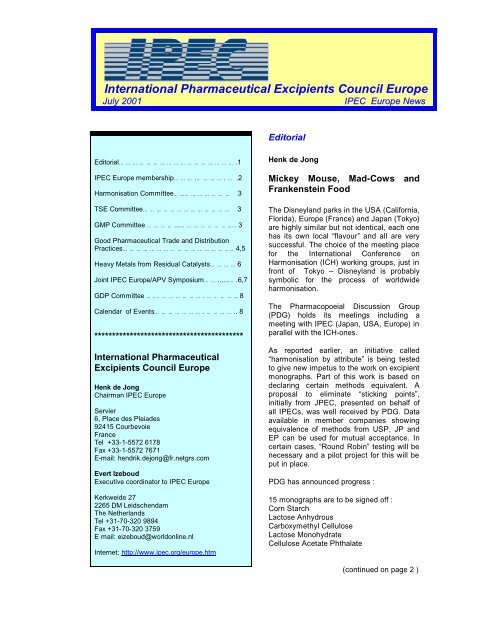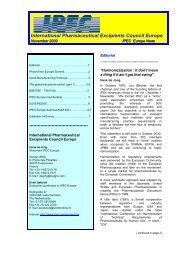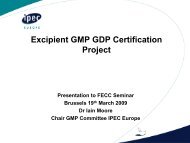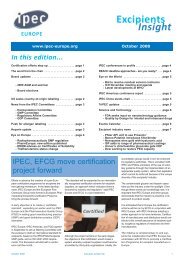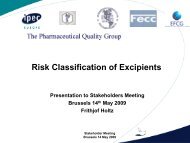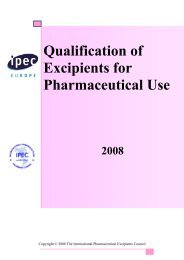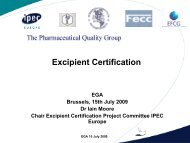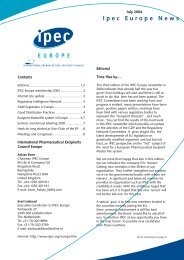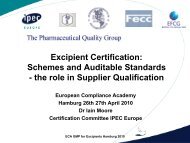International Pharmaceutical Excipients Council ... - IPEC Europe
International Pharmaceutical Excipients Council ... - IPEC Europe
International Pharmaceutical Excipients Council ... - IPEC Europe
Create successful ePaper yourself
Turn your PDF publications into a flip-book with our unique Google optimized e-Paper software.
<strong>International</strong> <strong>Pharmaceutical</strong> <strong>Excipients</strong> <strong>Council</strong> <strong>Europe</strong>July 2001<strong>IPEC</strong> <strong>Europe</strong> NewsEditorialEditorial… ………………………………………….1<strong>IPEC</strong> <strong>Europe</strong> membership… …….… ………. … .2Harmonisation Committee… ..… ……………… 3TSE Committee… ……………………………… 3GMP Committee … ………...… ………………..… 3Good <strong>Pharmaceutical</strong> Trade and DistributionPractices… ……………………………………. … 4,5Heavy Metals from Residual Catalysts… ………6Joint <strong>IPEC</strong> <strong>Europe</strong>/APV Symposium… …......… .6,7GDP Committee … .… ………………. … ……….. 8Calendar of Events… ………………. … ……….. 8******************************************<strong>International</strong> <strong>Pharmaceutical</strong><strong>Excipients</strong> <strong>Council</strong> <strong>Europe</strong>Henk de JongChairman <strong>IPEC</strong> <strong>Europe</strong>Servier6, Place des Pleiades92415 CourbevoieFranceTel +33-1-5572 6178Fax +33-1-5572 7671E-mail: hendrik.dejong@fr.netgrs.comEvert IzeboudExecutive coordinator to <strong>IPEC</strong> <strong>Europe</strong>Kerkweide 272265 DM LeidschendamThe NetherlandsTel +31-70-320 9894Fax +31-70-320 3759E mail: eizeboud@worldonline.nlInternet: http://www.ipec.org/europe.htmHenk de JongMickey Mouse, Mad-Cows andFrankenstein FoodThe Disneyland parks in the USA (California,Florida), <strong>Europe</strong> (France) and Japan (Tokyo)are highly similar but not identical, each onehas its own local “flavour” and all are verysuccessful. The choice of the meeting placefor the <strong>International</strong> Conference onHarmonisation (ICH) working groups, just infront of Tokyo – Disneyland is probablysymbolic for the process of worldwideharmonisation.The Pharmacopoeial Discussion Group(PDG) holds its meetings including ameeting with <strong>IPEC</strong> (Japan, USA, <strong>Europe</strong>) inparallel with the ICH-ones.As reported earlier, an initiative called“harmonisation by attribute” is being testedto give new impetus to the work on excipientmonographs. Part of this work is based ondeclaring certain methods equivalent. Aproposal to eliminate “sticking points”,initially from JPEC, presented on behalf ofall <strong>IPEC</strong>s, was well received by PDG. Dataavailable in member companies showingequivalence of methods from USP, JP andEP can be used for mutual acceptance. Incertain cases, “Round Robin” testing will benecessary and a pilot project for this will beput in place.PDG has announced progress :15 monographs are to be signed off :Corn StarchLactose AnhydrousCarboxymethyl CelluloseLactose MonohydrateCellulose Acetate Phthalate(continued on page 2 )
<strong>International</strong> <strong>Pharmaceutical</strong> <strong>Excipients</strong> <strong>Council</strong> <strong>Europe</strong>_____________________________________________________________2001 at a further to be defined venue in theUnited Kingdom.Good pharmaceutical trade anddistribution practices (part 1)EditorialThe following article below will be publishedin the WHO Drug Information in July 2001.<strong>IPEC</strong> <strong>Europe</strong> acknowledges the WHO forpermission to publish the text in <strong>IPEC</strong><strong>Europe</strong>’s Newsletter. The article will bepublished in two parts: In July part 1 and inOctober part 2)H. Leblanc, The <strong>Europe</strong>an ChemicalIndustry <strong>Council</strong> (CEFIC)F. Milek, <strong>International</strong> <strong>Pharmaceutical</strong><strong>Excipients</strong> <strong>Council</strong> (<strong>IPEC</strong>)Over the past sixty years, there have beenover 500 reported cases of fatal incidentsdue to the accidental but also fraudulentincorporation of diethylene glycol intopharmaceuticals (1). About 80 children diedin Haiti in 1996 as a result of contaminatedparacetamol syrup containing diethyleneglycol in glycerol used as an excipient.published recommendations (6,7). WHOGuidelines for the Manufacture of<strong>Pharmaceutical</strong> <strong>Excipients</strong> were published in1999 (8) although no equivalent ICHguideline yet exists. Although high qualityproduction standards will guarantee a goodquality product, they do not confirm that highquality starting materials are indeeddelivered to the pharmaceuticalmanufacturers.Industry has engaged in a voluntary programof responsible care and productstewardship, as set out on the followingpage. Such programs should ensure thatonly safe products are used. However, thebest programs cannot defeat all fraudulentpractices. Unscrupulous individualsconcerned with making quick and easymoney will continue to seek out anyloopholes in regulations and circumventsystems in particular when regulations areabsent or not enforced (9).How do these products reach the consumer ?When company A buys from manufacturingcompany B, does company A really receivea product made by company B? Hopefully,yes. But this is not always the case. Thecommercial practices described below areconsidered normal transactions in manycountries and demonstrate the difficultiesencountered in operating effective controlsystems.A similar case of diethylene glycol poisoningwas identified in India between April andJune 1999 (2). The WHO Drug Informationhas also published articles on other casesreported worldwide (3).WHO has developed guidelines on goodmanufacturing practices (GMP) for bothfinished pharmaceutical dosage forms andstarting materials (4), while other regulationsand guidelines continue to be issued. AGuideline on Good Manufacturing Practicefor Active <strong>Pharmaceutical</strong> Ingredients hasalso been approved by the <strong>International</strong>Conference on Harmonization (ICH) (5).Other bodies, such as the <strong>International</strong><strong>Pharmaceutical</strong> <strong>Excipients</strong> <strong>Council</strong> and theUnited States Pharmacopoeia, have1. Producer A has more orders on the books foractive ingredients than he can handle.Therefore, he orders products from company Bto be delivered in neutral drums (no labels,or peelable labels). He will then relabelthese drums with his own labels andreissue the certificate of analysis.2. Export company XYZ exports productsbearing its own labels, without reference tothe original producer. Additionally, thecompany may source from several differentproducers at the same time.3. A distributor repackages a product insmaller containers under its own name,without traceability to the original producer.Such practice is also fairly common insome <strong>Europe</strong>an companies which are notobliged to communicate the origin of the______________________________________________________________________________________July 2001 4 <strong>IPEC</strong> <strong>Europe</strong> News________________________________________________________________
<strong>International</strong> <strong>Pharmaceutical</strong> <strong>Excipients</strong> <strong>Council</strong> <strong>Europe</strong>_____________________________________________________________goods.(continued from page 4)(continued on page 4)principal impurity.These are not the only recurring fraudulentpractices by far. Several constructions areknown, often related to the registration4. A technical product or a food-gradeproduct is re-analyzed by thebroker/distributor and found compliant witha given pharmacopoeia, and relabeled asbeing of pharmaceutical quality.The above practices, and many more, havea potential impact because these productsare eventually administered to humans forsometimes quite serious health conditions.In all the cases above, there is no way toguarantee that the product originates from aplant where appropriate GMP standardshave been implemented. Absence ofcleaning validations, the use of low qualitywater, the use of unacceptable solventssuch as benzene, or process changes whichgo unreported and invalidated, can result inunsafe medicinal products. Recent FDAwarning letters indicate that some facilitieswho claim GMP compliance have nevercarried out the corrections they committed tomake in writing. Are these exceptions to therule, or are they the tip of the iceberg?Furthermore, if there is lack of traceability, avariable or unknown origin of the goods, allprocess validation files of the medicinalproducer are by definition meaningless,and this includes all the stability data.Processing conditions may vary dependingon the source of the starting materials, whichhas a direct impact on bioavailability andhence on the efficacy of the medicinalproduct.process or patent infringement. A lot ofmoney can be made by committing fraud,and the risks taken are sometimessignificantly lower than those, for example,of narcotics dealers for which capitalpunishment is often the penalty. Yet fraudwith medicinal products can be asdevastating to the end user as narcotics!References1. Wax, H. et al. Clinical Toxicology, 34(5):517Ð520 (1996).2. Bulletin of the World Health Organization,79(2): 88Ð95 (2001).3. WHO Drug Information, 11(3), 123 (1997).4. World Health Organization. QualityAssurance of <strong>Pharmaceutical</strong>s. Volume 2:Good Manufacturing Practices andInspection. Geneva, 1999.5. <strong>International</strong> Conference onHarmonization (ICH) documents availableon http://www.ifpma.org6. <strong>International</strong> <strong>Pharmaceutical</strong> <strong>Excipients</strong><strong>Council</strong>. Good Manufacturing PracticesGuide for Bulk <strong>Pharmaceutical</strong> <strong>Excipients</strong>(1997).7. United States Pharmacopoeia. GoodManufacturing Practices for Bulk<strong>Pharmaceutical</strong> <strong>Excipients</strong>, USP XXIV24,General Chapter 1078: 2040Ð2049, 2000.Pharmeuropa, 9(2): 302Ð322 (1997).Another frequent observation is thatproducts are being offered against obsoletepharmacopoeial standards. For example, atthe end of the year 2000, acetylsalicylic acidwas reported to have been offered, withcompliance stated against BPh 80 although8. World Health Organization. GMP:the British Pharmacopoeia monograph wasSupplementary Guidelines For Thechanged in 1986 and again in 2000. TheManufacture of <strong>Pharmaceutical</strong> <strong>Excipients</strong>.monograph change concerned relatedWHO Technical Report Series, No. 885,substances, suspected to be mutagenic and(1999).now limited at 0.1%. The samples of theproduct offered had over 0.2 % of the9. <strong>International</strong> Federation of<strong>Pharmaceutical</strong> Manufacturers Associations______________________________________________________________________________________July 2001 5 <strong>IPEC</strong> <strong>Europe</strong> News________________________________________________________________
<strong>International</strong> <strong>Pharmaceutical</strong> <strong>Excipients</strong> <strong>Council</strong> <strong>Europe</strong>_____________________________________________________________(IFPMA). Counterfeiting. Download file onhttp://www.ifpma.orgHeavy Metals from ResidualCatalystsOn the EMEA Internet site a Draft note forGuidance has been published on settinglimits for heavy metals originating fromresidual catalysts.<strong>IPEC</strong> <strong>Europe</strong> understands the need toprotect users of medicinal products from theintake of harmful substances such asmetallic elements used in the synthesis ofsome active pharmaceutical ingredients(APIs) and excipients. Hence in principleagrees with the aims of the draftguideline.Notwithstanding the actual limitsproposed in the draft guideline which will bebased on scientifically determined toxicitydata, the issue does bring to light someareas of concern.In order for the manufacturers of medicinalproducts to meet the requirements of thedraft guideline they need to be aware of theidentity of all potential metallic elementcatalysts that could be present in the API orexcipient for a particular dosage form.Materials frequently selected for use asexcipients have their own specific issuesassociated with them, in that many are itemsof commerce produced mainly for marketsectors other than the pharmaceuticalsector. They are produced and marketed ina fiercely competitive market and most arenot offered any protection by patents.<strong>IPEC</strong><strong>Europe</strong> predicts that the manufacturers ofthese materials will be reluctant to reveal tocustomers sensitive proprietary informationsuch as the identity of catalysts used in theirmanufacturing operations as this informationwould be difficult to protect using individualConfidentiality Agreements.Masterfile procedure for new ingredients orusing the Certificate of Suitability systemof the EDQM , for compendial articles. <strong>IPEC</strong>has written to the EMEA in thissense.Joint APV/<strong>IPEC</strong> <strong>Europe</strong> SeminarOctober 18 th and 19 th 2001On the occasion of <strong>IPEC</strong> <strong>Europe</strong>’s 10 thAnniversary the Board has decided toorganise a special symposium on<strong>Pharmaceutical</strong> <strong>Excipients</strong>. The Symposiumwill be organized in cooperation with theGerman APV and will be open forparticipants from both members and nonmembers.Many activities of regulatorybodies, authorities and industrialorganisations on quality assurance andsafety of starting materials are indicating alack of regulation and consumer healthprotection in that area.This conference is designed to inform allinvolved parties on recent developments andprovides a forum for discussion on hot topicsin the field of starting materials forpharmaceuticals. The combination ofspeakers and topics should bring togetherdifferent points of views and interests:starting materials manufacturing,distribution, medicinal productmanufacturing, regulation and inspection.The first session is dedicated to theregulatory situation and the supply chain ofstarting materials. Globalisation ofproduction and distribution of startingmaterials in the last decades changed theenvironment completely not only in thatarea. The "Haiti case” in 1996 when 80children died from a contaminated excipientin a medicinal product is only one indicationfor the problems of starting materials supplychain to be solved in the future.The second session is focussed on futuredirections in quality assurance of startingmaterials to bring together "makers” and"users”. To improve processes the cooperationof both is needed, because GMPis a relatively new topic for chemicalindustries manufacturing starting materials.Therefore information and discussion aboutcustomer needs becomes more importantfor these industries. The conference givesOne way forward on this issue would be fora mechanism to be developed wherebymanufacturers could pass the relevantinformation on to the competent authoritiesdirectly without putting sensitive data into thepublic domain, e.g by creating an Excipientthe possibility to discuss more about______________________________________________________________________________________July 2001 6 <strong>IPEC</strong> <strong>Europe</strong> News________________________________________________________________
<strong>International</strong> <strong>Pharmaceutical</strong> <strong>Excipients</strong> <strong>Council</strong> <strong>Europe</strong>_____________________________________________________________appropriate quality assurance and GMP inthe production of starting materials forpharmaceuticals.Symposium ProgramThursday, 18 October 20011.00 p.m. – 6.00 p.m.SUPPLY CHAIN MANAGEMENT OFSTARTING MATERIALSOpening and introductionDr. Günther HankePresident of APV, D-HeilbronnProf. Henk de JongChairman of <strong>IPEC</strong> <strong>Europe</strong>,F-CourbevoieRegulatory situation of starting materialsin <strong>Europe</strong>Speaker from EU CommissionRegulatory situation of starting materialsin the USSpeaker from FDACEFIC Guidelines for handling anddistribution of propylene glycol USP/EPDr. Mathias BrenkenChairman of CEFIC MPG USP distributionworkgroup, Dow Deutschland, D-Stade<strong>IPEC</strong>’s Good Distribution Practice forexcipientsDr. Frank Milek<strong>IPEC</strong> <strong>Europe</strong> Good Distribution PracticeCommittee, Aug. Hedinger GmbH & Co., D-StuttgartSourcing of starting materials under GMPregulatory requirementsDietmar KolbPurchasing Manager, Aventis PharmaDeutschland, D-FrankfurtProblems of starting materials globaltrade - an inspectors point of viewMarcel MoesterSenior Inspector, Health Care Inspectorate,NL-RijswijkFriday, 19 October 20019.00 a.m. – 4.00 p.m.FUTURE DIRECTIONS IN QUALITYASSURANCE OF STARTING MATERIALSHACCP in the production ofpharmaceutical excipientsDr. Ulla RichterDGF Stoess AG, D-EberbachPure excipients or monitored impuritiesin excipients?Why is monitoring of impuritiesnecessary?Carles VentosaUniqema, E-BarcelonaFuture packaging materials to improvemedicinal product stabilityEkkehard BeerTicona GmbH, D-FrankfurtFunctionality in tablet excipientsDr. Jan OmelkaMeggle GmbH, D-WasserburgImplementation of cGMP in themanufacture of excipientsDr. Hans HermansDMV <strong>International</strong>, NL-VeghelSupplier quality requirements: a viewfrom the pharma industryIgnace WallaertJanssen Pharmaceutica NV,B-Beerse______________________________________________________________________________________July 2001 7 <strong>IPEC</strong> <strong>Europe</strong> News________________________________________________________________
<strong>International</strong> <strong>Pharmaceutical</strong> <strong>Excipients</strong> <strong>Council</strong> <strong>Europe</strong>_____________________________________________________________guidance, will become a direct reference in<strong>IPEC</strong> GMP guidelines for excipients.Good Distribution PracticesCommitteeIn 2000 the Good Distribution PracticeCommittee (GDP) together with <strong>IPEC</strong>Americas finished the work on GDP AuditingGuidelines for distributors of excipients. Thisdocument was published also last year anddistributed to the <strong>IPEC</strong> <strong>Europe</strong> membership.Additionally a position paper on the subjectGDP was published. The main ideas of thatpaper were presented also in the October2000 edition of <strong>Pharmaceutical</strong> Technology<strong>Europe</strong>. If a reprint of that article is required,please call Evert Izeboud. A package ofposition paper and GDP Guidelines wassent to all relevant organisations in <strong>Europe</strong>for information.Now the GDP committee will continue itswork on promoting the use of that guidelinesand on informing all involved parties aboutthe importance of supply chain issues forsafety and quality of excipients.Because of job changes the <strong>IPEC</strong> <strong>Europe</strong>GDP committee needs new members tocontinue its work like described above. Thecontribution to that committee could also bevery helpful for excipient producersthemselves who intend to control more thesupply chain of their marketed excipientsand user who buy excipients fromdistributors. Volunteers of our membercompanies are kindly asked to contact:Dr. Frank MilekChairman of GDP CommitteeE-mail: milek.hedinger@t-online.deCalendar of EventsTherefore the GDP committee defined thefollowing action points:? Strategy for promotional worktargeted to distributors, makers andusers of excipients? Publication of <strong>IPEC</strong> GDPs inrelevant pharmaceutical journals? Organizing a seminar on the useand benefits of <strong>IPEC</strong> GDP AuditingGuidelines for <strong>IPEC</strong> members andnon-members? GDP as part of <strong>IPEC</strong> Americas thirdpartyauditing programAt the moment the revision process of <strong>IPEC</strong>GMP Guidelines for excipients is ongoing.For the revised version a separate chapterdealing exclusively with distribution aspectsof excipients is discussed. On that wayrelevant GMP requirements for distributorsand traders will become part of general<strong>IPEC</strong> GMP Guidelines. On that way <strong>IPEC</strong>´sGDP Auditing Guidelines, which are mainlya questionnaire with some additional______________________________________________________________________________________July 2001 8 <strong>IPEC</strong> <strong>Europe</strong> News________________________________________________________________
<strong>International</strong> <strong>Pharmaceutical</strong> <strong>Excipients</strong> <strong>Council</strong> <strong>Europe</strong>_____________________________________________________________(September-December 2001)6/9 Good Manufacturing PracticesUnited Kingdom10/9 Harmonization CommitteeAmsterdam Airport27+28/9 Management ForumLondon, Kensington Park8-10/10 <strong>IPEC</strong> <strong>Europe</strong> CPhI WorldwideLondon, United Kingdom17/10 Board MeetingDarmstadt,Germany18+19/10 <strong>IPEC</strong> <strong>Europe</strong>/APV SymposiumDarmstadt, Germany8+9/11 EDQM SymposiumCertification of SuitabilityAthens, GreeceNext <strong>IPEC</strong> <strong>Europe</strong> NewsletterThe next Newsletter is scheduled to beissued during the APV/<strong>IPEC</strong> <strong>Europe</strong>Seminar in Darmstadt (18 October 2001).<strong>IPEC</strong> <strong>Europe</strong> members who would like tocontribute to the this issue are invited tosubmit text electronically (maximum 1 A4) toMr Izeboud. Deadline: 30 September 2001.______________________________________________________________________________________July 2001 9 <strong>IPEC</strong> <strong>Europe</strong> News________________________________________________________________


